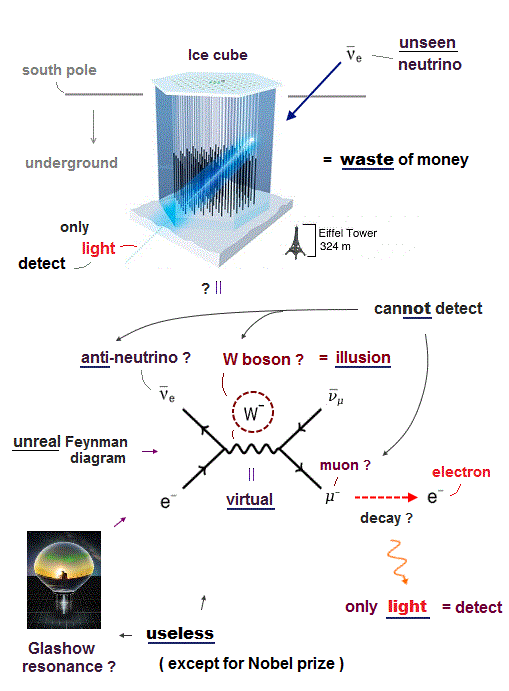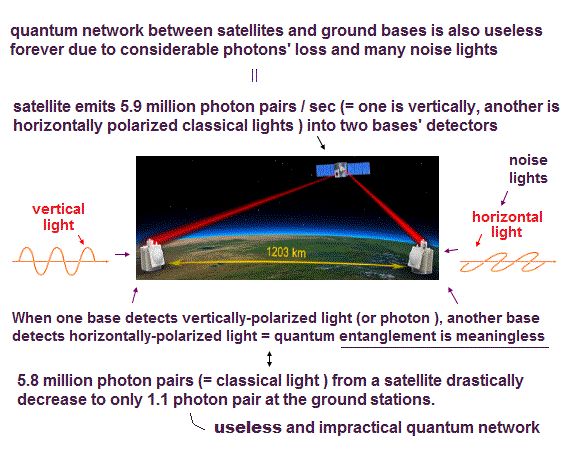
Home page
Quantum cryptography is hopeless
(Fig.1) Quantum information (= fragile photons or very weak light ) is easily lost by atmosphere, and a lot of background light causes information errors in satellite-based quantum communication.

Quantum communication, key distribution (= QKD ) sending quantum information (= very weak light or fictitious photons ) by using satellites is impractical ( this-lower-Challenges ).
Because the weak light or photons (= quantum information ) are easily lost by the atmosphere ( this 3rd-last-paragraph ), and irrelevant background light (= from stars or city light ) always causes errors or wrong quantum information ( this-challenges- 2nd-paragraph ).
Quantum internet or communication that needs to send or receive a lot of continuous errorless information is definitely impossible due to severe loss of photons or quantum information in today's impractical quantum network, contrary to hypes.
Satellite-based quantum key distribution experiments susceptible to weather condition ( this p.1-left-1st-paragraph ) were conducted only at night or in places without lights (= bright urban cities cause a lot of irrelevant background photons and errors ), but errors by irrelevant background light or photons can never be avoided ( this p.9-2nd-paragraph ).
This-p.13-left-1st-paragraph (5/10/2025) says
"there is No practical solution to achieve long-distance quantum communication
currently (even by using satellites )"
↑ Today's erroneous quantum key distribution needs ordinary classical communication's error correction (= so it is far better to use ordinary practical cheap classical communication from the beginning ) and makes the purpose of quantum communication meaningless.
This p.2-2nd-paragarph says -- useless quantum network
"Satellite communication, however, poses significant challenges, as they are costly to build, send to
space and maintain. Their availability depends on weather and atmospheric conditions that are difficult
to control."
This p.1-introduction-2nd-paragraph says -- massive photon loss
"The main challenge of long-distance free-space quantum communication are the high
photon losses in the channel, caused mostly by absorption, diffraction and turbulence in
the air"
This p.1-abstract says -- a lot of errors
"the number of secret bits that can be generated in a
single satellite pass over the ground station is severely restricted by the pass duration and the free-space
optical channel loss. High channel loss may decrease the signal-to-noise ratio due to background noise,
reduce the number of generated raw key bits, and increase the quantum bit error rate (QBER), all of
which have detrimental effects on the output secret key length"
This 17th-paragraph says
"The satellite cannot yet establish a real quantum key distribution link."
↑ Unlike ordinary strong classical information that can be freely amplified, sending each fragile quantum information (= very weak light or a single photon that is not allowed to be amplified ) to the exact pinpoint location by adjusting satellite's position and orientation is unrealistic and impossible.
Despite extremely long time researches even the latest Chinese satellite research cannot make practical quantum network, which is just wasting money, as the 3rd-last-paragraph of this ( this 3/19/2025 ) says
"This showcase for quantum technology has its limits. The Jinan-1 satellite “seems optimised for quantum key distribution, and is Not going to perform more general quantum communication tasks" ← useless quantum network.
↑ This research paper-p.23-last says
"During the experiment, the moon entered the field of view of the ground telescope, causing a significant
increase in dark counts and consequently raising the QBER (= quantum bit error rate ) of the sifted key packet."
↑ Just the slight moon light increases the quantum key error rate drastically, which must be corrected by the ordinary classical communication, so today's error-prone quantum key distribution using fragile photons (= weak light ) as messengers is useless, meaningless.
Unlike ordinary classical communication, quantum communication via satellites is inconvenient, impractical, useless.
This-p.2-2nd-paragraph (2025) says -- Impractical satellites
"One of the primary challenges lies in the
cryptographic key distribution process. Satellites must be preloaded with cryptographic keys before launch, requiring
secure and reliable key management protocols. Once in orbit, synchronizing these keys across the entire
constellation is crucial to maintaining secure communications"
↑ So quantum keys (= fragile photons ) can Not be sent from some senders on the ground to receivers on the ground through satellites by quantum communication, instead, they have to preload the quantum key emitters onto satellites before launch, which is impractical.
This latest research also just sent fragile quantum information (= weak light ) one-way from satellite to the ground, combined with ordinary classical (= optical ) communication ( this-p.19-Fig.1a, this-4th-paragraph )
Practical communication via satellites needs uplink (= send information from ground stations to satellites ) and downlink (= satellites send back the information to other ground places, ), which is impossible in quantum network due to massive photon loss.
This-5-6th, 9th paragraphs (11/5/2025) say
"Current quantum satellites create entangled pairs in space and then send each half of the pair down to two places on Earth – called a downlink"
"uplink approach wouldn't work due to signal loss"
"The researchers suggest the uplink concept (= only uplink without downkink, so useless ) could be tested in the near future (= still impossible )"
↑ Practical communication needs both uplink and downlink signals at the same time, which is impossible in the fragile quantum information.
(Fig.2) Only one photon (= one bit information ) per 5.9 million photons reached the destination, which massive photon loss makes quantum internet impossible forever.

In the recent experiment using Chinese satellite, about 5.9 million pairs of photons or weak lights per second (= 5.9 MHz, one light is horizontally-polarized and the other light is vertically-polarized in each pair ) were emitted from a satellite toward two separate ground stations which were about 500 ~ 1600 km away from the satellite.
And only about one pair of photons (= 1.1 photons or 1.1 Hertz, this-7~8th-paragraphs ) per second were successfully detected by two ground stations, which rate is too low to be practical quantum communication
↑ When one ground station detected a horizontally-polarized light, the other ground station detected a vertically-polarized light, which they called "entanglement" that has nothing to do with superluminal spooky link. ← quantum entanglement is a meaningless, useless concept.
↑ One photon pair out of 5.9 million pairs of photons emitted from the satellite reached the destination = the success rate is only 0.00000017 ← This was too low success rate to be useful.
↑ This or this original paper ↓
p.1-abstract says -- only useless downlink
"Here we demonstrate
satellite-based distribution of entangled photon pairs to two locations separated by
1203 kilometers on Earth, through two satellite-to-ground downlinks (= only one way from satellite to the ground )" ← sending photon or quantum information from the sender on the ground to the receiver was impossible
p.2-left-2nd-paragraph says "the distance between the satellite and two ground stations ( at an altitude of about 3000m ) is 500~2000km".
p.2-left-3rd-paragraph (or this p.3-last-paragraph ) says -- Error-prone
"we established entanglement between two single photons.. with an average two-photon count rate of 1.1 Hz and state fidelity of 0.869 (= which means even the small numbers of sent photons that reached ground stations at a rate of one photon per second showed the error rate of 0.131 (= 1 - 0.869 ) or 13.1% error, which cannot be used as practical key )"
p.2-left-last says -- Massive photon loss
"The source emits 5.9 million entangled photon pairs per second (= entangle means just a pair of photons; one light is vertically-polarized V and the other light is horizontally-polarized H, ← meaningless entanglement, No superluminal spooky link )"
p.3-right-1st-paragraph this same paper says -- Noise errors
"the background noise ranged from 500 to 2000 counts/s in each detector (= which caused errors that must be corrected by ordinary classical communication, so quantum information is meaningless )"
↑ The total success probability of sending pairs of photons to two ground stations from the satellite is only 1.1/5.9 million = 0.00000017 (= 99.99999% photons or quantum information were lost ), which is too bad and too slow to use as practical communication or internet.

Feel free to link to this site.